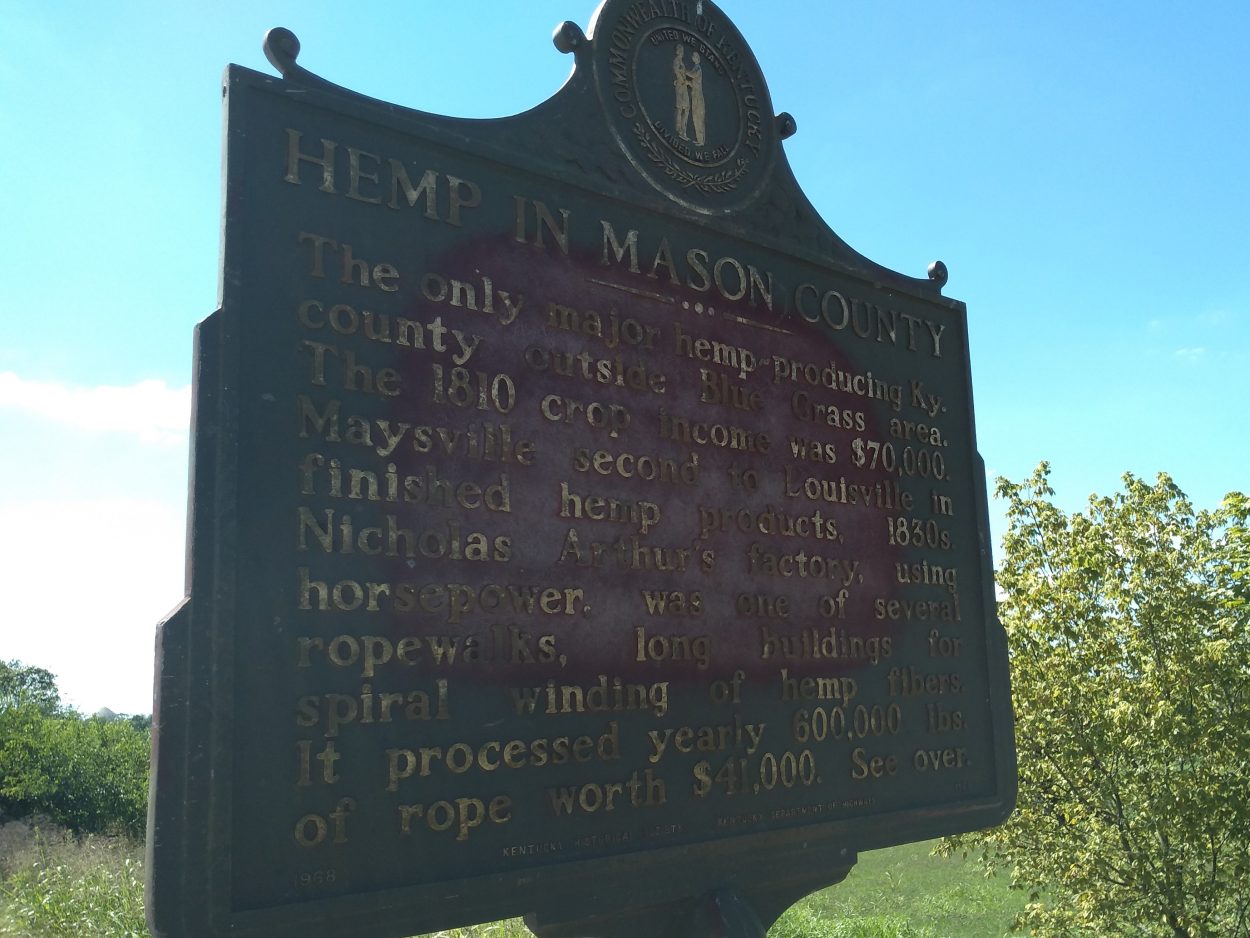Historical Marker # 1165 Hemp in Mason County

Hemp In Mason County (US 68 West Just Past Maysville Community College
Location:
US 68 West just past the entrance to Maysville Community College, Mason County
Marker Text:
“The only major hemp producing Kentucky County outside the Blue Grass area. The 1810 crop income was $70,000. Maysville second to Louisville in finished hemp products, 1830s. Nicholas Arthur’s factory, using horsepower, was one of several ropewalks, long buildings for spiral winding of hemp fibers. It processed yearly 600,000 lbs. of rope worth $41,000.”
Mason County’s Hempstory:
The Return of the Missing Sign:
The May 21 , 1989 Lexington Hearld Leader reported that the Hemp in Mason County historical marker had been found. Originally located in downtown Maysville, at the intersection of Second Street and KY 8, the marker disappeared in 1982. Initially valued at $1,000, for 7 years people debated what happened to the sign. In 1989 the sign mysteriously reappeared at the bus stop by the entrance to Maysville Community College. It was rededicated in its new location on US 68 not long after.
Maysville, Gateway into Kentucky.
In 1775 frontiersman Simon Kenton established the first settlement in the area. Originally called Limestone, Maysville (named of early settler John May) was incorporated in 1787.
Maysville was Kentucky’s most important port from its earliest settlement until the later half of the 19th Century. By 1830 Maysville was one of Kentucky’s most important commercial centers. Maysville was both a critical port for bringing people and goods into frontier Kentucky, and an important port for shipping Kentucky goods to markets down river. These goods included hempen products, tobacco and bourbon whiskey.
By the 1840’s Maysville had earned the reputation of being one of the largest hemp markets in the world. A combination of raw hemp fiber destined for manufacturers along the east coast and agricultural baling materials bound for the cotton plantations of the deep south flowed out of central Kentucky, into Maysville and out to the rest of the country.
Hemp Pioneers
Being a market and a port to export products is only one way in which Mason county residents contributed to the Kentucky hemp industry. Adam Beatty studied law in Lexington under the tutelage of Henry Clay’s brother in law, James Brown. He moved to Mason county in 1802 and was commissioned as a judge in the circuit court. He retired from the judiciary in 1823 and devoted his life to developing his farm. Immersing himself in the latest American and European agricultural theory, Beatty established himself as one of Kentucky’s leading agronomists. Beatty served as Vice-President of the Kentucky Agricultural Society and was a prolific writer. His essay “On the Cultivation of Hemp” earned Beatty a prize of $20 in 1841.
Michael Ryan was Maysville’s largest hemp merchant in 1841. His large home, now on the National Registry of Historic places, sits on 2nd Street overlooking the Ohio River. Ryan was one of 32 known “Emancipators”. The emancipators were group of wealthy citizens who created avenues to freedom for enslaved people. Often emancipators took out loans to purchase enslaved people. They would then enter into a contract where the enslaved person repaid the loan, securing their own freedom.
Lewis Collins Documents Kentucky’s Hemp History
In 1846 Kentucky historian Lewis Collins published his landmark, Historical Sketches of Kentucky. The book was an ambitious attempt to document as much Kentucky history as possible, with an emphasis on documenting the stories of many of Kentucky’s original pioneers.
Published at the peak of Kentucky’s antebellum hemp industry, Collins compiles contemporary information providing a snapshot of the Kentucky hemp industry. His synopsis includes information about agricultural production and other economic activity. This information includes the number of hemp factories operating in a given community.
There are flaws in how the book is documented, however Collins is credited with obtaining many first person accounts of Kentucky’s frontier era. As a result, his work is considered essential.
In 1877 his son Richard Collins updated and revised the book. The younger Collins presented the book to the state for use as a textbook. Unfortunately for Collins the state declined.
Other Points of Interest:
Mayville’s Kentucky Gateway Museum is a great place to learn about this vital city in the Kentucky narrative.
